Rare books and ephemera can be a fascinating avenue to examine the past and understand what was really happening during significant events or time periods. We took a deep dive into the database to see what light our members offerings could shine on America's new favorite drama...
The Queen's Gambit
Netflix's #1 new show is the coming-of-age story of a female chess prodigy struggling with addiction and the chauvinism inherent in 1960's American society. Based on Walter Tevis's 1983 novel of the same name, the show is being talked about for many reasons, not the least of which is the way it revels in decidedly analog pleasures -- the slow, methodical game of chess itself and the fashions of the 1960s -- and a very retro style of editing at odds with the frantic pace of modern television. At the same time, its vision of glass ceilings shattering and the importance of a team of like-minded friends to support each other speaks directly to issues very much on our minds at the current moment.
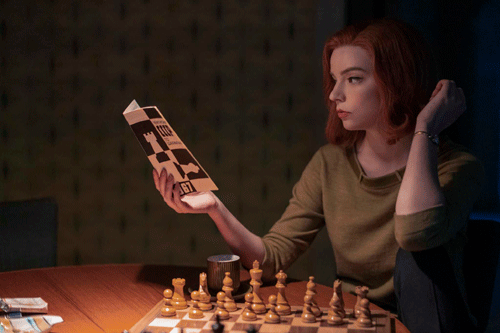
Chess lovers have noted the accuracy and care with which the chess games themselves are depicted, which is no surprise considering the show recruited Grand Master Garry Kasparov and noted chess instructor Bruce Pandolfini (who also helped proof-read the original novel!) to oversee the gameplay and coach the actors on the nuances of competitive chess. In this time of social isolation, games like chess are discovering new fans and inspiring older ones to return to the board (the so-called "pandemic bump" reported in the spring). Now, The Queen's Gambit is inspiring others to put down the remote control and take out their chess set. Two-time United States Women's Chess Champion, Jennifer Shahade (author of the books Chess Bitch and Play Like a Girl) has reported that, since the series premiered, many women are learning to play chess: "I'm seeing a big rise in the number of girls — but also especially the number of teens and adult women who are signing up for our various programs."
ABAA members offer a great many books on chess, including many by grand master's name-checked in the show, as well as some fascinating artifacts and mementos of some of the chess world's most-famous players.
Beginners may want to consult some of these instructional books:
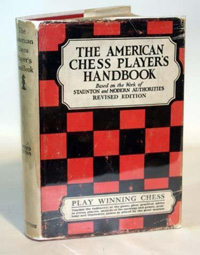
The American Chess Player's Handbook Based On The Work of Staunton And Modern Authorities
by Howard Staunton
Philadelphia: The John C. Winston Company, c1928, 1934. Revised Edition. Near fine in bright red cloth covered boards with gilt text on the spine and the same on the front board. A 16mo measuring 6 1/2" by 4 1/2". In a very good-, unclipped dust jacket with small chips from the corners of the spine area and fore corners of the panels together with related creasing and light wear. 256 pages illustrated with a frontispiece and drawings of games played.
Offered by Town's End Books.
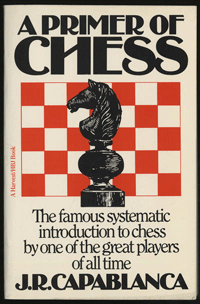 A Primer of Chess
A Primer of Chess
by J.R. Capablanca -- the first grand master Beth Harmon learned about!
New York: Harcourt, Brace, Jovanovich, 1983. Softcover. Fine. Later printing. Fine in wrappers.
Offered by Between the Covers Rare Books.
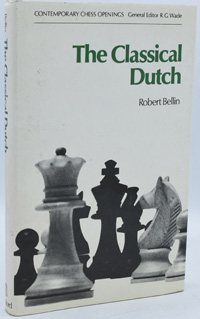
The Classical Dutch
by Robert Bellin
London: B. T. Batsford, 1977. Hard Cover. Very Good binding/Good dust jacket. Some foxing to the endpapers and edges of the textblock. Black cloth. Very Good binding / Good dust jacket.
Offered by Black Swan Books.
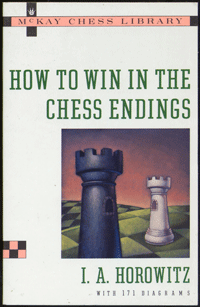
How To Win in the Chess Endings
by Israel Horowitz
New York: David McKay, 1957. Softcover. Fine. Later printing. Fine in pictorial wrappers.
Offered by Between the Covers Rare Books.
Browse more books about chess...
Modern Chess Openings
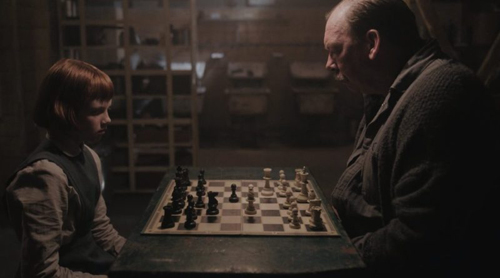
In the first episode, Mr. Shaibel gives Beth her first book about chess. It is Modern Chess Openings by Richard Clewin Griffith and John Herbert White -- known as "MCO" to generations of chess enthusiasts. Originally published in 1911, the book has been frequently revised and later editions have had a variety of editors. A copy of any edition not only contains time-tested chess strategy, but would make a great gift for anyone inspired to improve their game by The Queen's Gambit.
Chess in the Soviet Union
As we saw in the series, chess was a major obsession in the Soviet Union, and grand masters there were celebrities more akin to movie stars. ABAA-member The Book Collector specializes in chess (among other areas) and currently offers some wonderful cancellation covers that illustrate how chess championships were major events in the Soviet Union.
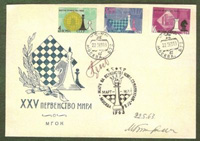
Cancellation Cover Commemorating the World Chess Championship Rematch of 1963
Signed by Tigran Petrosian & Mikhail Botvinnik
One sheet cover with cancelled stamp and decorative chess board in black on beige paper. Commemorative cancel to stamp. Signed by both players, Tigran Petrosian in red ink and Mikhail Botvinnik in blue ink, dated by Botvinnik 22 May 1963. Stamped in Moscow.
Event covers are decorated, stamped and canceled commemorative envelopes. They are created to celebrate an event or note an anniversary. The design (called a "cachet") is generally placed on the left side of the envelope (although there are also "all over" cachets). It explains what is being commemorated on what date, and some times includes an illustration page. Ideally, the stamps used relate to the celebration. Cancels are either obtained in the city of the event. If a special cancellation (one with a design) has been created for the event, you can generally only receive that cancel from the local post office.
At the World Chess Championship 1963 Tigran Petrosian narrowly qualified to challenge Mikhail Botvinnik for the World Chess Championship, and then won the match to become the ninth World Chess Champion. The cycle is particularly remembered for the controversy surrounding the Candidates' Tournament at Curaçao in 1962, which resulted in FIDE changing the format of the Candidates Tournament to a series of knockout matches.
Condition: Some edge wear with the top opening being slit in very good condition.
Offered by The Book Collector, Inc.
Cancellation Cover Commemorating the World Chess Championship Rematch of 1961
Signed by Mikhail Tal & Mikhail Botvinnik
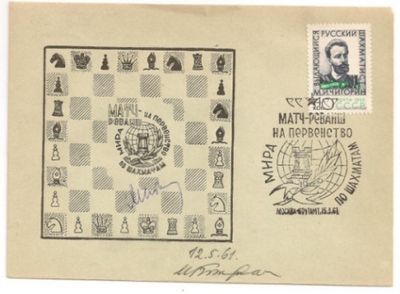
One sheet cover with cancelled stamp and decorative chess board in black on light green paper. Commemorative cancel to stamp. Signed by both players, Mikhail Tal and Mikhail Botvinnik, in blue ink, dated by Botvinnik 12 May 1961.
Event covers are decorated, stamped and canceled commemorative envelopes. They are created to celebrate an event or note an anniversary. The design (called a "cachet") is generally placed on the left side of the envelope (although there are also "all over" cachets). It explains what is being commemorated on what date, and some times includes an illustration page. Ideally, the stamps used relate to the celebration. Cancels are either obtained in the city of the event. If a special cancellation (one with a design) has been created for the event, you can generally only receive that cancel from the local post office.
Mikhail Tal (Latvian: Mihails Tāls; Russian: Михаил Нехемьевич Таль, Michail Nechem'evič Tal, [mʲixʌˈiɫ nʲɪˈxɛmʲɪvʲit͡ɕ ˈtal]; sometimes transliterated Mihails Tals or Mihail Tal; November 9, 1936 – June 28, 1992) was a Soviet-Latvian chess Grandmaster and the eighth World Chess Champion. Widely regarded as a creative genius and the best attacking player of all time, he played in a daring, combination style. His play was known above all for improvisation and unpredictability. Every game, he once said, was as inimitable and invaluable as a poem. He was often called "Misha", a diminutive for Mikhail, and "The magician from Riga". Both The Mammoth Book of the World's Greatest Chess Games (Burgess, Nunn & Emms 2004) and Modern Chess Brilliancies (Evans 1970) include more games by Tal than any other player. Tal was also a highly regarded chess writer. He also holds the records for both the first and second longest unbeaten streaks in competitive chess history.On May 28, 1992, dying from kidney failure, he left hospital to play at the Moscow blitz tournament, where he defeated Garry Kasparov. He died one month later. The Mikhail Tal Memorial is held in Moscow each year since 2006 to honor his memory.
Mikhail Moiseyevich Botvinnik, PhD (Russian: Михаи́л Моисе́евич Ботви́нник, pronounced [mʲixaˈiɫ̺ mʌiˈs̺ʲɛjɛvʲitʃʲ bʌt̺ˈvʲin̺n̻ʲik]; August 17 [O.S. August 4] 1911 – May 5, 1995) was a Soviet and Russian International Grandmaster and three-time World Chess Champion. Working as an electrical engineer and computer scientist at the same time, he was one of the very few famous chess players who achieved distinction in another career while playing top-class competitive chess. He was also a pioneer of computer chess. Botvinnik was the first world-class player to develop within the Soviet Union (Alekhine was a top player before the Russian Revolution), putting him under political pressure but also giving him considerable influence within Soviet chess. From time to time he was accused of using that influence to his own advantage, but the evidence is unclear and some suggest he resisted attempts by Soviet officials to intimidate some of his rivals. Botvinnik also played a major role in the organization of chess, making a significant contribution to the design of the World Chess Championship system after World War II and becoming a leading member of the coaching system that enabled the Soviet Union to dominate top-class chess during that time. His famous pupils include World Champions Anatoly Karpov, Garry Kasparov and Vladimir Kramnik.
The 1961 World Chess Championship was played between former champion Mikhail Botvinnik and champion Mikhail Tal in Moscow from March 15 to May 13, 1961. Tal had unseated Botvinnik in the 1960 match, thus Botvinnik was entitled to this rematch the next year. Botvinnik, a Russian, defeated Latvian Tal to regain the world championship.
Condition: Some edge wear with the top opening being slit in very good condition.
Offered by The Book Collector, Inc.
Chess Review
It you're looking to channel your inner Beth Harmon or learn more about the mid-century chess world, check out a few copies of The Chess Review (no shoplifting required!):
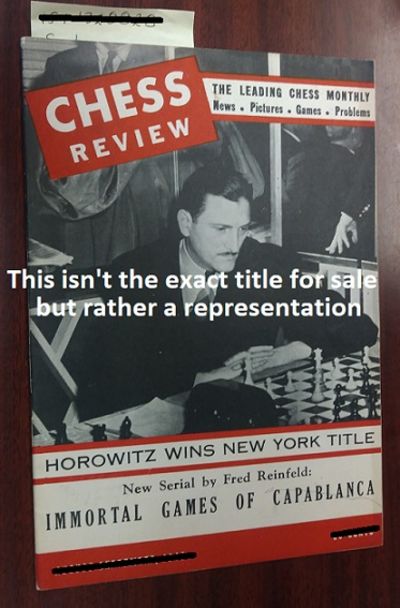
THE CHESS REVIEW. VOL. 10, NO. 10, DECEMBER 1942
Israel A. Horowitz, editor.
New York: Chess Review, 1942. Saddle-stitched. Octavo; G; Paperback; Spine, staple binding; Cover is illustrated with white and black print, pencil notation and slight stain on front, light shelfwear and age-toning; Text block has slight pencil marking on pp. 259-261, else clean and tight; "Official organ of the U.S. Chess Federation"; paged 241-272, illustrated.
Offered by Second Story Books (who have many other issues of The Chess Review available!).
The Experts Behind The Queen's Gambit
Tevis himself was an enthusiastic chess player of "Class C" standard (a regular tournament player who enjoys the game, but doesn't progress very far -- the kind of player Beth Harmon would have defeated in the early rounds of open tournaments), and his knowledge of and love for the game was evident to early reviewers. Tevis also had the good sense to make use of his connections in the chess world of the time to get feedback and advice as he was crafting the novel. American chess instructor Bruce Pandolfini gave feedback on the manuscript, and 35 years later acted as an advisor to the filmmakers -- as well as appearing on-screen in the sixth episode, "Adjournment," as Ed Spencer, the director of a local chess tournmament. Pandolfini also recruited former World Chess Champion Garry Kasparov, who -- as a former child prodigy -- was able to give the filmmakers valuable insight into the world of Russian chess, international competition, and the pressures of being a child with such heavy expectations on your shoulders.
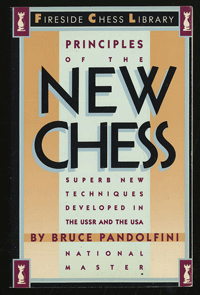
Principles of the New Chess
by Bruce Pandolfini
New York: Simon & Schuster/Fireside, 1986. Softcover. Fine. Fifth printing. Fine in wrappers.
Offered by Between the Covers Rare Books.
HOW LIFE IMITATES CHESS: MAKING THE RIGHT MOVES FROM THE BOARD TO THE BOARDROOM [SIGNED]
by Garry Kasparov -- grand master & chess consultant for The Queen's Gambit!
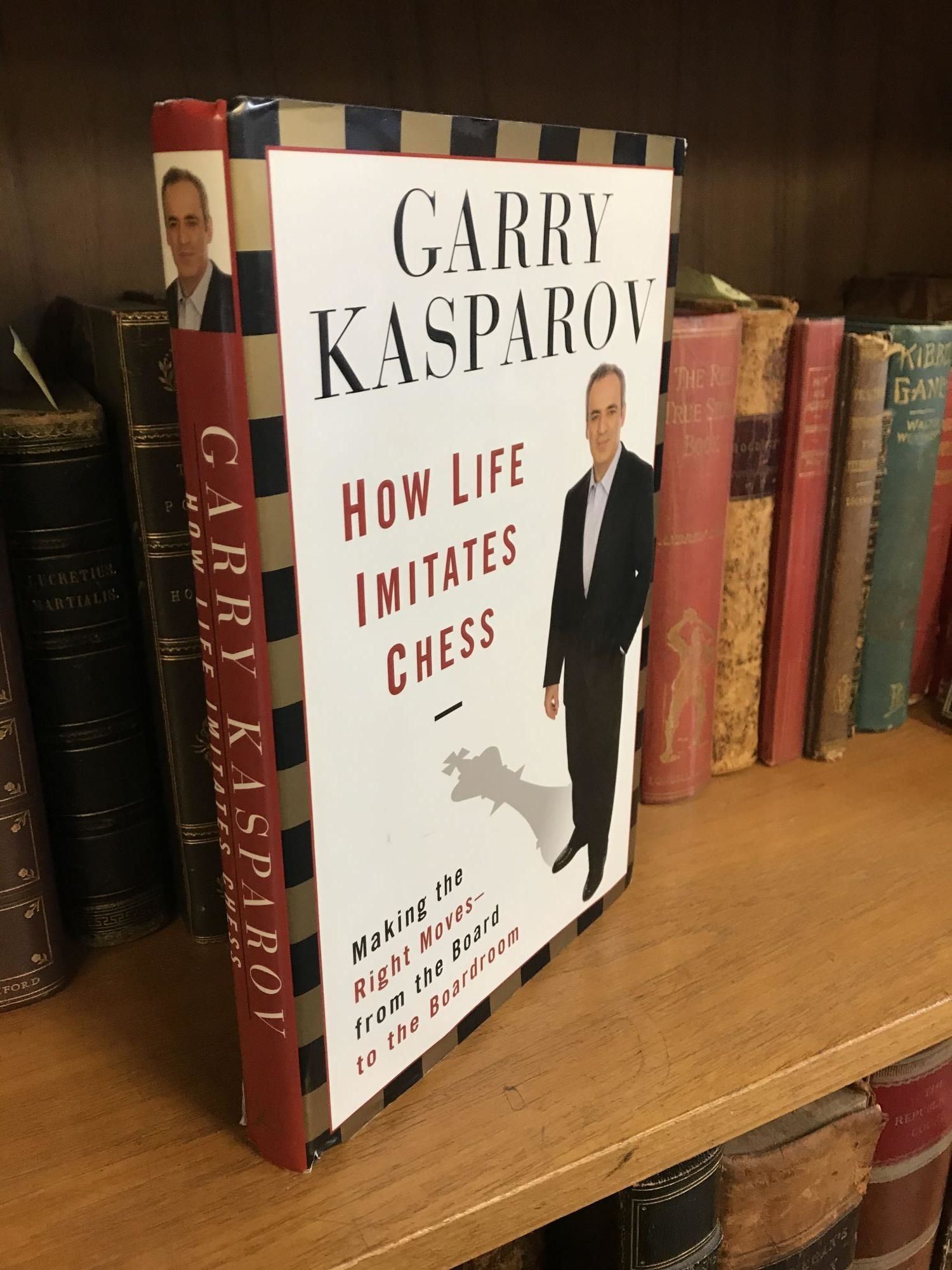
New York: Bloomsbury, 2007. First Edition, First Printing. Hardcover. Octavo, 224 pages; VG/G+; red spine with white lettering; dust jacket protected by a mylar cover; price uncut "$25.95"; some shelf wear an tearing to the edges of the dust jacket, pages clean; signed, dated, and inscribed by Garry Kasparov on the ffep; LH consignment; shelved in case 8 1/2. 1332956.
Offered by Second Story Books.
Garry Kasparov on Garry Kasparov: Volumes I-3
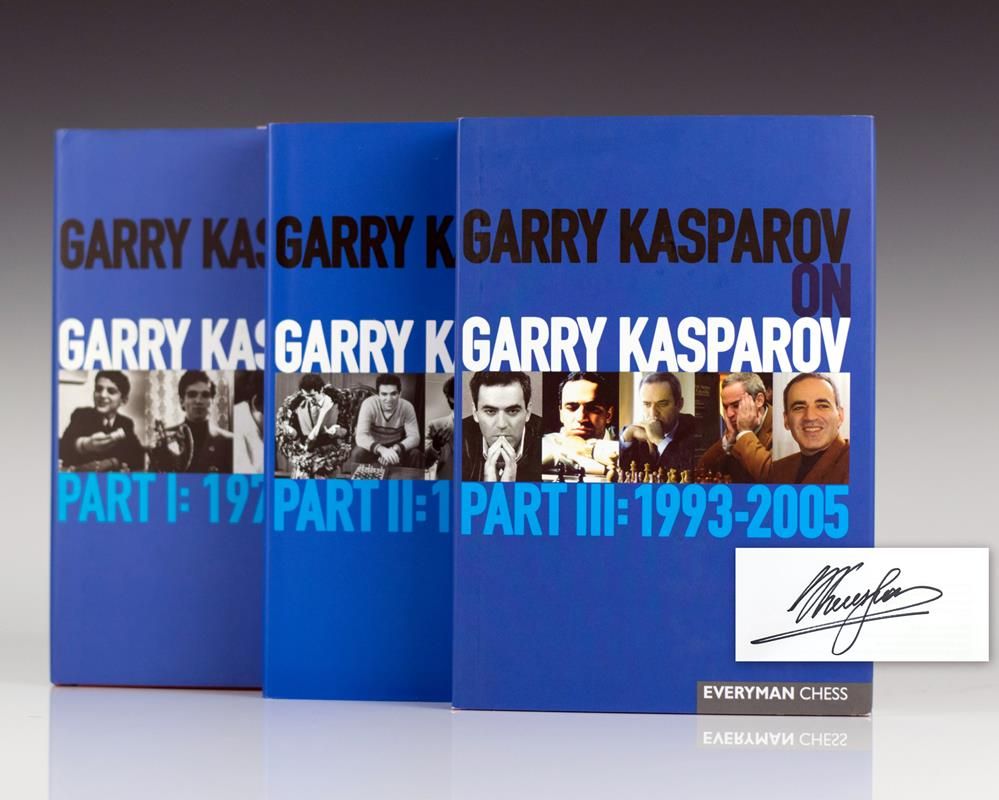
London: Evveryman Chess, 2011-14. First editions of each volume. Octavo, original cloth, three volumes. Each is signed by Garry Kasparov on the title page. Each are fine in a fine dust jacket. Garry Kasparov on Garry Kasparov is a major three-volume series, which records the greatest chess battles played by the greatest chessplayer of all-time. The series in itself is a continuation of Kasparov's mammoth history of chess, comprising My Great Predecessors and Modern Chess. Kasparov's historical volumes have received great critical and public acclaim for their rigorous analysis and comprehensive detail regarding the developments in chess that occurred behind the scenes. This new volume and series continues in this vein with Kasparov scrutinising his most fascinating encounters from the period 1973-1985 whilst also charting his development away from the board.
Offered by Yesterday's Muse.
Who Was Beth Harmon Based On?
It's tempting to imagine that Walter Tevis might have based Beth Harmon on the real-life teenage chess sensation Bobby Fischer, whose career paralled the timeframe of the series. Tevis dismissed this, writing in the novel's "author's note" that while the "superb chess of Grandmasters Robert Fischer, Boris Spassky and Anatoly Karpov has been a source of delight to players like myself for years. Since The Queen's Gambit is a work of fiction, however, it seemed prudent to omit them from the cast of characters, if only to prevent contradiction of the record." Tevis had a daughter, Julie, and talked of his desire to create an unapologetically smart female character, unlike most male American novelists of the time. He considered "The Queen's Gambit a tribute to brainy women,” and wanted to celebrate “Beth for her bravery and intelligence" because "in the past, many women have had to hide their brains, but not today.''
The nearest the chess world has come to a real-life Beth Harmon may be the career of the Russian Vera Menchik, who so dominated women's chess in the 1920s and '30s that she was regularly invited to compete at men's chess tournaments, where she defeated many noted grand masters! Menchik is one of the famous chess players pictured in thie portfolio of photographs offered by The Book Collector:
Le Monde des Eches
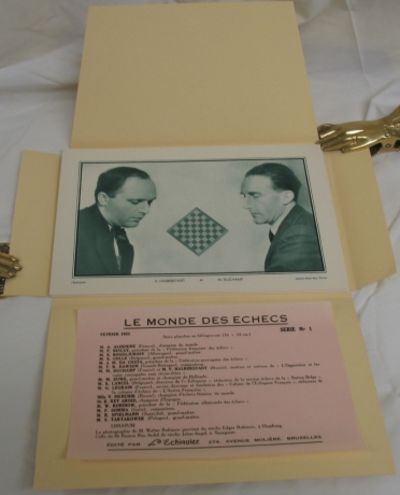
A collection of 16 photographs of various chess players, including Alekhine, Euwe, Menchik and Tartakower. Oblong duo decimo (6 1/4" x 9 1/2") There is a leaf with a description of those featured on the photos. In original paper portfolio. Series 1. First edition.
The picture of M Duchamp and V Halberstadt was taken at the Man Ray Studio in Paris. The photographs of T R Dawson was taken at the G Chic Studio, E D Bogoljuboff at F Clauss, in Landau, Joao Maria da Costa taken at J & M Lazarus Studio in Lisbon, Francisco Somma at Fratelli Seffer Studio in Polorme, Edomond Lancel, Walter Robinow ands Edgar Colle at R Demester Studios in Brussels, Rudolf Spielman at Josef Kayda Studios in Vienna, Dr R Rey Rdid at Jalon-Angel Studios in Barcelona, Salivelly Tartakower and Pierre Biscay at Pierre Auradon Studios in Paris, Mile Vera Menchik at Herbert Vandyk Studios in London, Alexander Alekhine and Max Euwe unknown studies.
Condition: A near fine set with slight soiling to portfolio.
Offered by The Book Collector.
And, if you're not totally soured on politics by our recent election, you might appreciate this 1972 chess set based on the leading American politicians of the day:
The Contemporary Game: Chess-'72
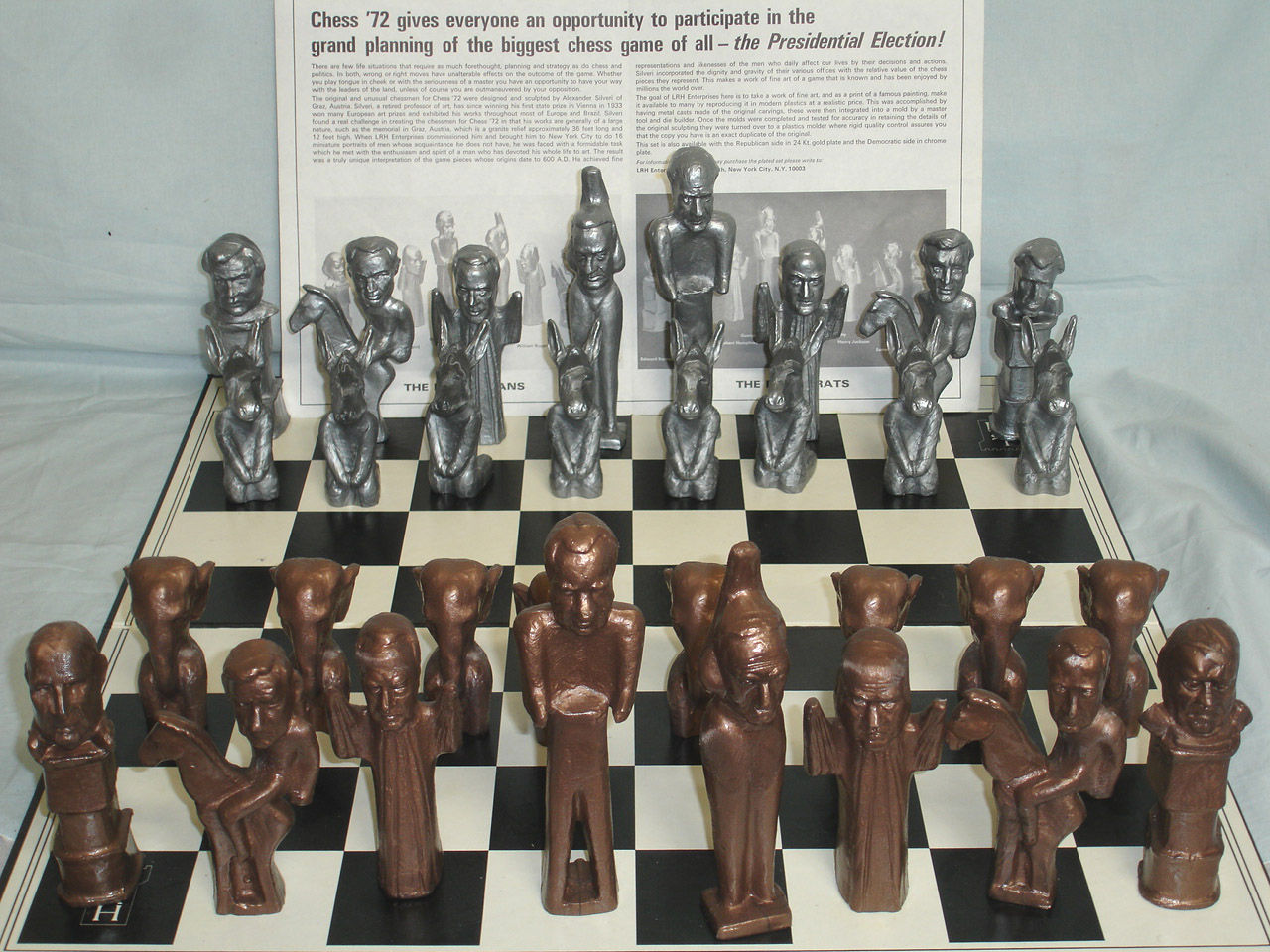
The original and unusual chessmen for Chess '72 were designed and sculpted by Alexander Silveri of Graz, Austria. Silveri, a retired professor of art, has since winning his first state prize in Vienna in 1933, won many European art prizes and exhibited his works throughout most of Europe and Brazil. Each piece is molded from ridged plastic. The set includes George McGovern, Richard Nixon, Henry Kissinger, Eugene McCarthy, J. Edgar Hoover, Edward Kennedy and more. All housed in original black box with board.
Offered by Alcuin Books.
Is The Queen's Gambit Autobiographical?
One autobiographical element in The Queen's Gambit is Beth's drug addiction. Author Walter Tevis wrote that as a child he "was diagnosed as having a rheumatic heart and given heavy drug doses in a hospital. That's where Beth's drug dependency comes from in the novel." Tevis also explored this element of his own life story in his 1963 novel, The Man Who Fell to Earth (adapted as a film starring David Bowie). The Queen's Gambit had been one of Tevis's lesser-known novels -- mainly because several of the others have been made into movies (The Hustler, The Color of Money, and the aforementionned The Man Who Fell to Earth -- but with the success of the Netflix adaptation it's safe to assume a new generation of interested readers will seek the novel out!
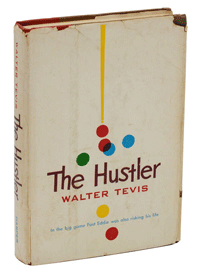 The Hustler
The Hustler
by Walter Tevis
New York: Harper & Brothers, 1959. First Edition. Very Good+/Good+. First edition. 214 , (1) pp. Original red cloth and gray paper covered boards, spine stamped in gilt. Very Good+ with bumped corners in edge-chipped and lightly soiled dust jacket, two mends on verso, and yet unsunned and unclipped, Good+. The inspiration for the 1961 Robert Rossen film starring Paul Newman as "Fast Eddie" and Jackie Gleason as "Minnesota Fats.
Offered by Burnside Rare Books.
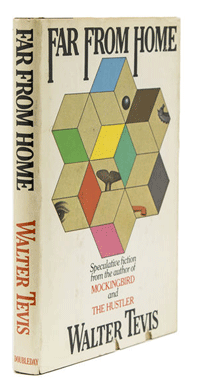 Far from Home
Far from Home
by Walter Tevis
Garden City, New York: Doubleday, 1981. First edition. 1 vols. 8vo. Cloth backed boards. Fine in very good plus dust jacket by Paul Bacon. Inscribed on the flyleaf to Hilary Knight. First edition. 1 vols. 8vo. Inscribed to Hilary Knight. Inscribed by the author "For Hilary with great affection, Walter Tevis 11/13/81"
Hilary Knight, illustrator of the Eloise books, was a close friend of Tevis from when they served together in the U.S. Navy before embarking on their successful literary and artistic careers.
Offered by James Cummins Bookseller.
Browse all books by Walter Tevis currently listed by our members...
* Please note, our members' inventory changes constantly, and books featured in this article are subject to prior sale. If you are in search of a particular book and do not see it listed, we encourage you to contact any ABAA member, as each have far more books in stock than they can ever list online. Members are happy to search for specific items and editions, and if they do not have something in stock, will likely know where to track one down. You can find a searchable index of ABAA members here...


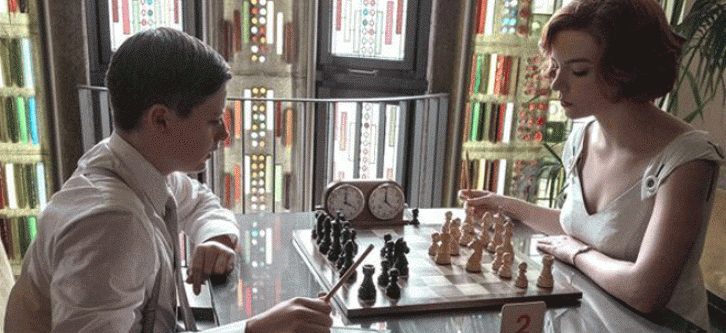


 A Primer of Chess
A Primer of Chess










 The Hustler
The Hustler Far from Home
Far from Home